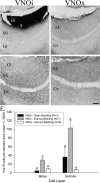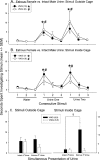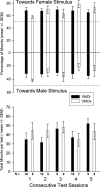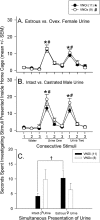Olfactory sex discrimination persists, whereas the preference for urinary odorants from estrous females disappears in male mice after vomeronasal organ removal
- PMID: 15496681
- PMCID: PMC6730103
- DOI: 10.1523/JNEUROSCI.2376-04.2004
Olfactory sex discrimination persists, whereas the preference for urinary odorants from estrous females disappears in male mice after vomeronasal organ removal
Abstract
Based on observed changes in the social context for the display of ultrasonic vocalizations, scent marking, aggression, and mounting behavior by male mice with a null mutation of the transient receptor potential 2 ion channel, it was proposed recently that a primary function of the mouse vomeronasal organ (VNO)/accessory olfactory system is sex discrimination. We tested this hypothesis directly by studying the ability of male mice to discriminate between urinary odors of conspecifics of the two sexes and in different endocrine states using habituation-dishabituation tests. Male mice from which the VNO had been surgically removed (VNOx) resembled sham-operated controls (VNOi) in their ability to discriminate between volatile urinary odors from estrous females versus gonadally intact males, as well as between urinary odors from estrous versus ovariectomized females and from gonadally intact versus castrated males. When physical access to stimuli was permitted, VNOi control males strongly preferred to investigate volatile and nonvolatile urinary odorants from estrous females as opposed to intact males, whereas VNOx males showed no such preference. Mating performance in tests with estrous females was equivalent in VNOi and VNOx subjects. Both groups of males preferred to mount an estrous female instead of a castrated male. Our results suggest that the VNO is not required for sex discrimination but instead detects the nonvolatile components of opposite-sex urine that may be used to help prolong contact with individuals that produce these chemosignals.
Figures




Similar articles
-
Effects of vomeronasal organ removal on olfactory sex discrimination and odor preferences of female ferrets.Chem Senses. 2004 Oct;29(8):659-69. doi: 10.1093/chemse/bjh069. Chem Senses. 2004. PMID: 15466811 Free PMC article.
-
Effect of vomeronasal organ removal from male mice on their preference for and neural Fos responses to female urinary odors.Behav Neurosci. 2006 Aug;120(4):925-36. doi: 10.1037/0735-7044.120.4.925. Behav Neurosci. 2006. PMID: 16893298 Free PMC article.
-
Adult testosterone treatment but not surgical disruption of vomeronasal function augments male-typical sexual behavior in female mice.J Neurosci. 2009 Jun 17;29(24):7658-66. doi: 10.1523/JNEUROSCI.1311-09.2009. J Neurosci. 2009. PMID: 19535577 Free PMC article.
-
Importance of olfactory and vomeronasal systems for male sexual function.Physiol Behav. 2004 Nov 15;83(2):177-87. doi: 10.1016/j.physbeh.2004.08.013. Physiol Behav. 2004. PMID: 15488538 Review.
-
Female recognition and assessment of males through scent.Behav Brain Res. 2009 Jun 25;200(2):295-303. doi: 10.1016/j.bbr.2008.12.020. Epub 2008 Dec 25. Behav Brain Res. 2009. PMID: 19146884 Review.
Cited by
-
An endocannabinoid system is present in the mouse olfactory epithelium but does not modulate olfaction.Neuroscience. 2015 Aug 6;300:539-53. doi: 10.1016/j.neuroscience.2015.05.056. Epub 2015 May 30. Neuroscience. 2015. PMID: 26037800 Free PMC article.
-
Vasopressin differentially modulates the excitability of rat olfactory bulb neuron subtypes.Front Neural Circuits. 2024 Aug 29;18:1448592. doi: 10.3389/fncir.2024.1448592. eCollection 2024. Front Neural Circuits. 2024. PMID: 39268350 Free PMC article.
-
Ethanol induces conditioned social preference in male mice.Alcohol Clin Exp Res. 2014 Apr;38(4):1184-92. doi: 10.1111/acer.12342. Epub 2014 Jan 24. Alcohol Clin Exp Res. 2014. PMID: 24460901 Free PMC article.
-
Effect of bilateral accessory olfactory bulb lesions on volatile urinary odor discrimination and investigation as well as mating behavior in male mice.Physiol Behav. 2008 Feb 27;93(3):467-73. doi: 10.1016/j.physbeh.2007.10.005. Epub 2007 Oct 12. Physiol Behav. 2008. PMID: 17991495 Free PMC article.
-
Categorization of biologically relevant chemical signals in the medial amygdala.Brain Res. 2009 Mar 31;1263:33-42. doi: 10.1016/j.brainres.2009.01.048. Epub 2009 Feb 5. Brain Res. 2009. PMID: 19368822 Free PMC article.
References
-
- Baum MJ, Keverne EB (2002) Sex difference in attraction thresholds for volatile odors from male and estrous female mouse urine. Horm Behav 41: 213-219. - PubMed
-
- Baum MJ, Brown JJ, Kica E, Rubin BS, Johnson RS, Papaioannou VE (1994) Effect of a null mutation of the c-fos proto-oncogene on sexual behavior of male mice. Biol Reprod 50: 1040-1048. - PubMed
-
- Beauchamp GK, Martin IG, Wysocki CJ, Wellington JL (1982) Chemoinvestigatory and sexual behavior of male guinea pigs following vomeronasal organ removal. Physiol Behav 29: 329-336. - PubMed
-
- Beckman M (2002) When in doubt, mice mate rather than hate. Science 295: 782. - PubMed
Publication types
MeSH terms
Grants and funding
LinkOut - more resources
Full Text Sources
